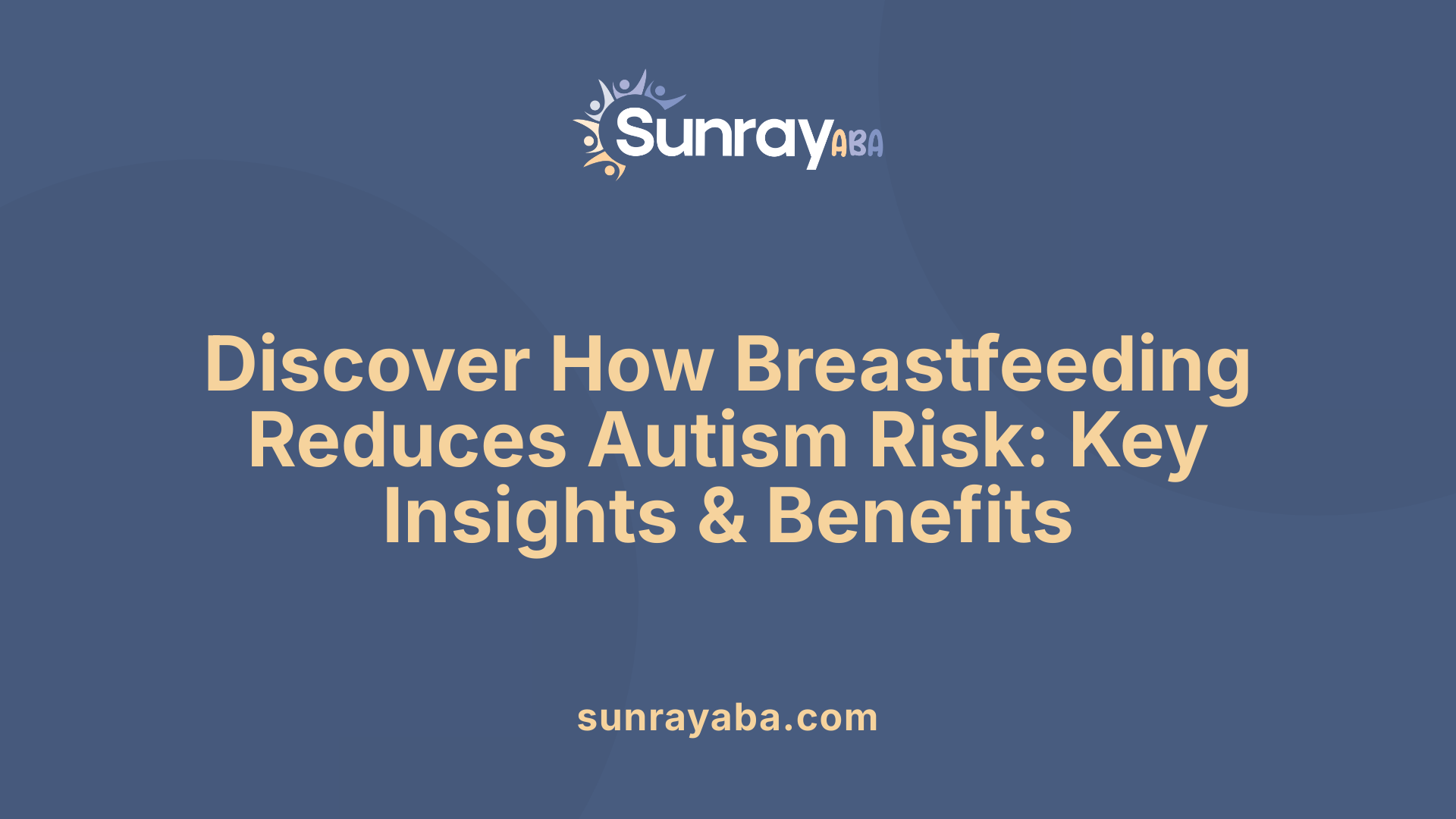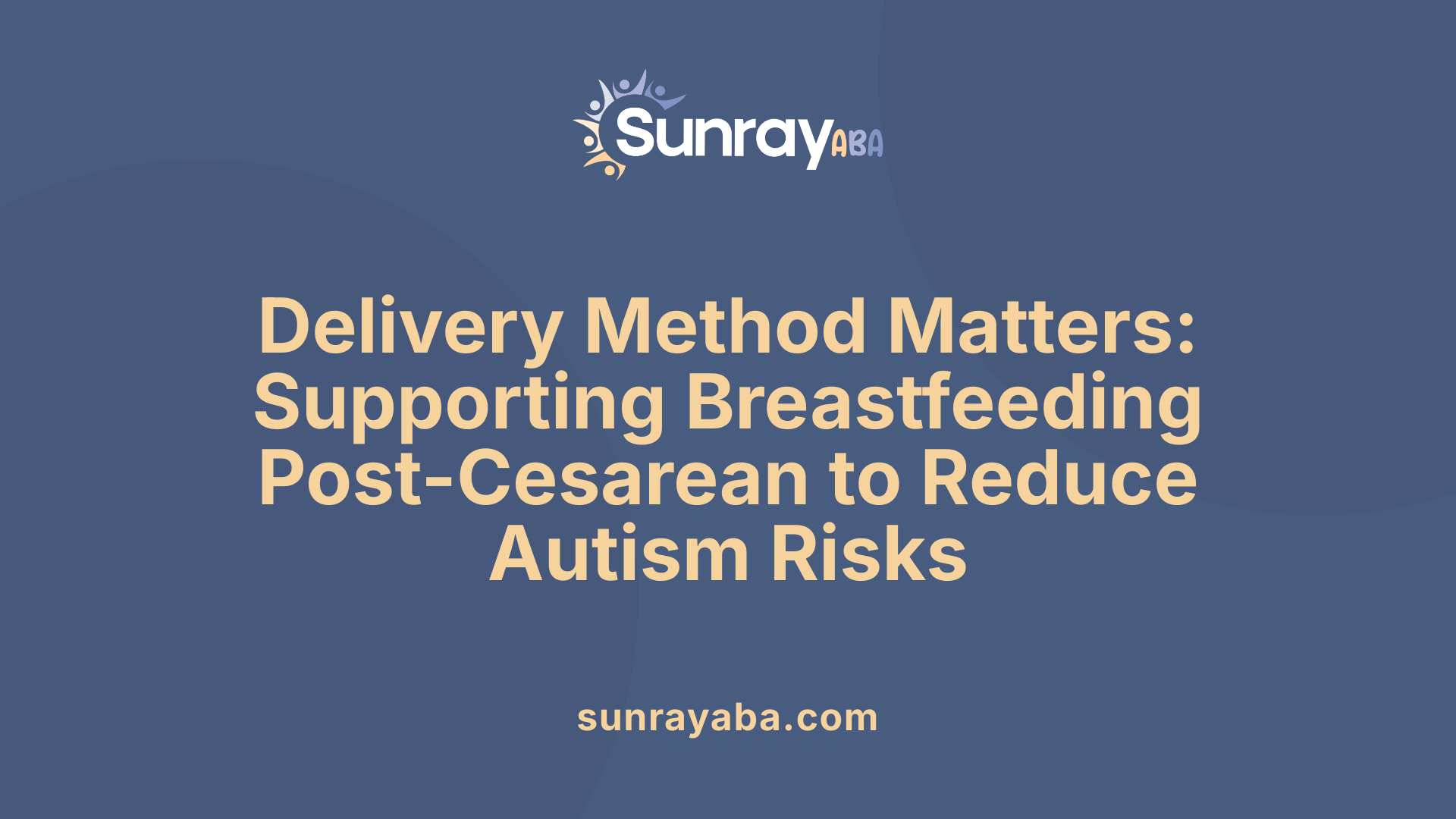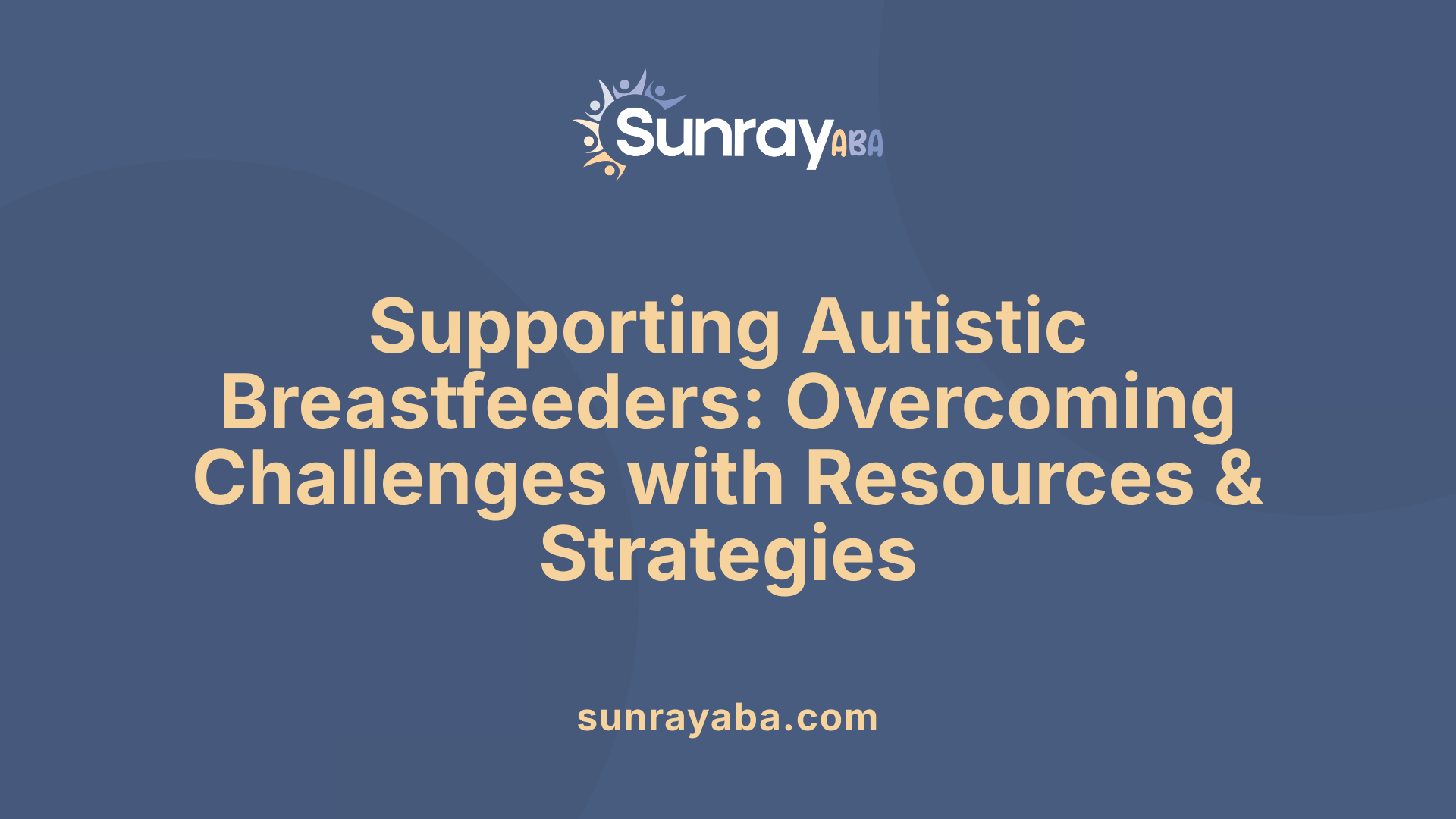Breastfeeding And Autism

Understanding the Complex Relationship Between Infant Nutrition and Autism
Recent scientific research underscores the potential protective effects of breastfeeding against autism spectrum disorder (ASD). This article explores the evidence linking breastfeeding practices with autism risk, examines biological mechanisms, highlights challenges faced by autistic children and their parents, and discusses implications for early intervention and ongoing support.
Breastfeeding and Its Protective Effect Against Autism

Does breastfeeding reduce the risk of autism?
Extensive research indicates that breastfeeding plays a significant role in reducing the risk of autism spectrum disorder (ASD). High-quality observational studies and systematic reviews have shown that children who are breastfed have a lower likelihood of developing ASD. Specifically, the meta-analysis analyzing data from seven studies with over 3,200 individuals found that children who were never breastfed had about an 81% increased risk of ASD compared to those who were breastfed.
The benefits are even more pronounced with exclusive breastfeeding, which has been associated with a 76% decrease in ASD risk. Moreover, longer durations of breastfeeding further enhance protective effects. For instance, breastfeeding for 12 to 24 months correlates with the most substantial reduction in ASD risk, illustrating a dose-dependent relationship.
Biological mechanisms that underpin these effects are being increasingly understood. Components such as fatty acids essential for brain development, immune-modulating factors, and increased oxytocin release during breastfeeding may support optimal neurodevelopment. These factors could help explain the association between breastfeeding and reduced ASD prevalence.
While some studies suggest that breastfeeding might also influence behavioral outcomes in children already diagnosed with ASD, the primary scientific consensus emphasizes its role in lowering the risk of diagnosis. Promoting optimal breastfeeding practices, including longer durations and exclusive breastfeeding when possible, is a promising approach to neurodevelopmental health.
Optimal Duration of Breastfeeding for Autism Prevention

How long should a baby be breastfed to potentially lower the risk of developing autism?
Research indicates that the duration of breastfeeding can have a significant influence on reducing the risk of autism spectrum disorder (ASD). Multiple studies show that longer periods of breastfeeding are associated with greater protective effects.
Specifically, breastfeeding for at least 12 months has been linked to a 54% reduction in ASD risk, while extending breastfeeding to 12–24 months offers even more notable benefits. The most substantial decrease in autism risk appears to occur when children are breastfed for 12 to 24 months.
A comprehensive meta-analysis, which included 7 high-quality observational studies with a total of 3,270 individuals, supports this finding. The analysis demonstrated that children who were not breastfed had approximately 1.8 times higher odds of developing ASD compared to those who breastfed. Remarkably, the studies showed no heterogeneity, meaning the results were consistent across different populations and research settings.
The evidence suggests that sustained breastfeeding beyond the initial months is beneficial. While lengthening breastfeeding duration is not a guaranteed preventive measure, it is associated with a sizable decrease in the likelihood of autism. Healthcare professionals often recommend breastfeeding for as long as possible within individual circumstances, aiming for at least 12 months or longer to maximize potential neurodevelopmental benefits.
In summary, breastfeeding for at least 12 months, and ideally up to 24 months, is associated with the lowest risk of ASD, emphasizing the importance of extended postnatal nutrition for healthy brain development.
Impact of Delivery Method on Breastfeeding and Autism-Related Behaviors

Does delivery method, such as cesarean section, impact breastfeeding and autism-related behaviors?
Delivery by cesarean section (CS) has been linked to delays in both the start of breastfeeding and the achievement of exclusive breastfeeding milestones.
Research shows that children born via CS are more likely to experience delayed initiation of breastfeeding and later onset of lactogenesis, making it more challenging to establish successful breastfeeding routines.
These delays often result in shorter durations of exclusive breastfeeding, particularly at the 4-month mark. Data indicate that infants exclusively breastfed at this stage are less likely to exhibit autism-like behaviors at 18 months and 3 years.
A significant finding from recent studies is that the lack of exclusive breastfeeding at 4 months acts as a mediator between CS delivery and early autism-related behaviors.
Structural equation modeling suggests that the relationship between cesarean birth and autism-like behaviors is partly explained by reduced breastfeeding at 4 months, which diminishes the protective effects of breastfeeding on neurodevelopment.
Mechanistically, cesarean deliveries may impact neurodevelopment through several biological pathways, including disrupted oxytocin release, alterations in microbiota colonization, and hormonal changes during birth.
Supporting breastfeeding after cesarean birth, therefore, is crucial. Such support can help bridge the gap caused by delivery method, potentially reducing the risk or severity of ASD-related behaviors.
In summary, cesarean section can influence breastfeeding success, which subsequently affects neurodevelopmental outcomes. Enhancing breastfeeding support post-CS can be an important strategy to help mitigate autism-related risks.
Biological Pathways Connecting Breastfeeding and Autism Risk Reduction

What is known about the biological mechanisms linking breastfeeding and autism?
The connection between breastfeeding and a reduced risk of autism spectrum disorder (ASD) involves multiple biological pathways, though the full picture is still under investigation. Breast milk provides essential nutrients like long-chain omega-3 and omega-6 fatty acids, fundamental for brain growth and neural development. These fatty acids support the formation of neural connections and myelination, crucial processes in early neurodevelopment.
Beyond nutrition, breast milk contains immunomodulatory factors that promote a healthy immune system, which is increasingly recognized to influence neurodevelopment. The immune system's modulation can help reduce neuroinflammation, a process linked to ASD.
Hormones such as oxytocin, released during suckling, play a significant role in social bonding and may positively impact social and emotional brain circuits. Elevated oxytocin levels are associated with enhanced social behaviors and could potentially reduce ASD-related social deficits.
Additionally, breastfeeding influences levels of insulin-like growth factor 1 (IGF-1), a growth promoter critical for brain maturation. Higher IGF-1 levels from breastfeeding might support neural growth and plasticity, mitigating some developmental vulnerabilities.
Breastfeeding also fosters a beneficial gut microbiome, with bioactive compounds like human milk oligosaccharides (HMOs) encouraging the growth of beneficial bacteria such as Bifidobacterium and Lactobacillus. These microbes help establish the gut-brain axis, which influences neurodevelopment and behavior.
In sum, nutrition, hormonal effects, immune support, and microbiome development through breastfeeding likely work together in a complex manner. These mechanisms support healthy brain development and may lower the likelihood of ASD, emphasizing the importance of extended and exclusive breastfeeding to maximize these neuroprotective benefits.
Challenges Faced by Autistic Individuals and Support Resources

What challenges do autistic children and parents face regarding breastfeeding, and what support resources are available?
Autistic children may encounter various breastfeeding challenges primarily related to sensory sensitivities. These sensitivities can include discomfort with certain textures, sounds, or lights, making the breastfeeding environment overwhelming. Children with autism might also experience oral motor difficulties, gagging, choking, or differences in sucking and swallowing patterns, which can hinder effective feeding and affect growth and nutrition.
Parents of autistic children often face heightened stress and fatigue due to these feeding issues. They may also experience social isolation, as managing sensory sensitivities can limit outings or social interactions during breastfeeding. Feelings of guilt, frustration, or failure are common, especially if breastfeeding does not proceed as expected or if the child exhibits early signs of autism that complicate feeding.
Support resources are crucial for navigating these challenges. Lactation consultants trained in autism-specific feeding support can offer tailored guidance on positioning, nipple shields, and feeding strategies. Healthcare professionals knowledgeable about autism can develop individualized plans considering sensory issues and medical needs.
Peer support networks, both online and community-based, provide emotional reassurance and practical advice from families experiencing similar challenges. Early intervention programs can assist in addressing feeding problems and promoting optimal nutritional intake.
Community resources, educational workshops, and multidisciplinary teams—including occupational therapists, speech therapists, and dietitians—help create comprehensive support plans. Facilitators such as early recognition of feeding difficulties, social support, and coordinated care significantly improve the breastfeeding experience.
Supporting autistic children during breastfeeding involves adopting a family-centered, holistic approach that respects the child's sensory preferences and medical conditions. Consistent access to specialized support and information empowers parents to overcome obstacles and foster healthy feeding routines.
Early Signs of Autism and Their Possible Links to Breastfeeding Patterns
How early can signs of autism be linked to breastfeeding practices?
Research shows a notable connection between breastfeeding habits and the development of autism spectrum disorder (ASD). Children diagnosed with ASD tend to be breastfed for shorter periods, averaging around 5 months compared to 6.6 months in neurotypical (TD) children. They are also less likely to be exclusively breastfed during their first year. These differences are persistent even when excluding infants with other health issues.
Longer breastfeeding durations, particularly beyond 12 months, are associated with a significant reduction in ASD risk. Specifically, breastfeeding for more than a year correlates with a lower likelihood of autism, and breastfeeding for 12–24 months offers the most substantial protective effect.
Early feeding behaviors can also serve as subtle indicators. Children with ASD often show delayed or atypical breastfeeding behaviors, such as uncoordinated latch, choking, gagging, or a lack of contentment during feeds. They may also have feeding difficulties that extend beyond the neonatal period, including oral motor challenges and difficulties with weaning. Recognizing these behaviors early can help healthcare professionals and parents identify potential neurodevelopmental concerns.
Moreover, the timing of introducing solids plays a role—delaying solids after 6 months is associated with higher ASD risk. Together, these feeding patterns provide valuable clues; however, they should be considered alongside other developmental observations.
In summary, while breastfeeding duration and early feeding behaviors are not definitive signs of autism, they are important markers that, when observed collectively, can contribute to earlier detection. Early identification allows for timely interventions, which can improve outcomes for children at risk of ASD.
Breastfeeding Challenges for Autistic People and Adaptive Strategies
Are children with autism less likely to breastfeed successfully?
Research indicates that children with autism spectrum disorder (ASD) often have shorter breastfeeding durations compared to neurotypical (TD) children. For instance, children with ASD tend to be breastfed for an average of 5.0 months, whereas TD children are breastfed for about 6.6 months. Moreover, fewer children with ASD are exclusively breastfed in the first year—only around 25% at 0-3 months—compared to nearly 38% in TD children.
Many factors influence breastfeeding success among autistic infants. These include oral motor difficulties, sensory sensitivities, and challenges with routines associated with breastfeeding. Sensory sensitivities, such as hypersensitivity to touch, smell, or texture, can make the physical act of breastfeeding more complicated. Despite these hurdles, it is important to recognize that many autistic individuals and their parents express a strong desire to breastfeed. While some children with ASD may face more obstacles, with proper support, breastfeeding goals can often be achieved.
Additional complexities involve early signs like uncoordinated latch, gagging, or the child showing little interest in nursing, which might be early indicators of autism. However, more research is needed to fully understand the relationship between autism and breastfeeding success.
What adaptations or strategies help autistic breastfeeding individuals?
Supporting autistic individuals in breastfeeding requires tailored approaches and understanding. Many autistic parents find value in adjusting their environment and routines to facilitate breastfeeding. Strategies include:
- Breastfeeding in a distraction-free environment to minimize sensory overload.
- Using nipple shields or other feeding aids to reduce discomfort or difficulty with latch.
- Giving oneself permission to use alternative feeding methods like pumping, bottle feeding, or formula when needed.
Communication from healthcare professionals plays a crucial role. Clear, straightforward information and respecting personal boundaries—such as asking permission before touching—are essential. Accommodating sensory sensitivities, like adjusting lighting, noise levels, or tactile support, can make a significant difference.
Support from lactation consultants trained to work with autistic parents, peer groups, and community resources can provide emotional reassurance, practical tips, and ongoing encouragement. Many autistic people are motivated to breastfeed despite their challenges, and with the right support, they can achieve fulfilling breastfeeding experiences.
Additional considerations
Understanding that sensory sensitivities may cause discomfort during breastfeeding, some autistic individuals may experience the milk ejection reflex as painful or uncomfortable. Temporary aversions can occur, especially in noisy, bright, or busy environments. Strategies to address this include breastfeeding in calm settings, using soft lighting, or employing calming techniques.
Overall, personalized adaptations and respectful support are vital in ensuring autistic parents can breastfeed successfully and comfortably, fostering bonding and promoting infant health despite sensory or behavioral difficulties.
The Role of Breastfeeding in Early Intervention and Autism Screening
How does breastfeeding relate to early intervention or autism detection?
Breastfeeding behaviors can offer valuable clues for early detection of autism spectrum disorder (ASD). Certain feeding patterns, such as uncoordinated latch, choking, gagging, or a persistent lack of satisfaction during feeds, may reflect early signs of sensory sensitivities or oral-motor difficulties common in infants later diagnosed with ASD.
These atypical behaviors during breastfeeding can serve as early indicators for healthcare providers and parents to observe closely. Recognizing these signs early allows for timely screening, monitoring, and intervention, which are crucial for supporting an infant’s neurodevelopment.
Studies suggest that early detection based on feeding behaviors, complemented by other developmental signs, can facilitate earlier intervention. This proactive approach can improve outcomes by addressing sensory or communication challenges sooner.
Healthcare professionals are encouraged to consider feeding patterns as part of routine infant assessments. Parental awareness and reporting of unusual breastfeeding behaviors are also important. When identified early, tailored support and interventions can be implemented, potentially mitigating some neurodevelopmental risks and fostering better developmental trajectories.
Integrating Cultural and Religious Practices with Modern Science
Cultural and religious traditions significantly influence breastfeeding practices around the world. For instance, some communities emphasize extended breastfeeding, aligning with scientific findings that longer durations—up to 12-24 months—offer substantial neurodevelopmental benefits, including a reduced risk of autism spectrum disorder (ASD). In many cultures, religious teachings also support prolonged breastfeeding; the Qur’anic guidance, for example, recommends two years of breastfeeding, which coincides with scientific evidence promoting extended breastfeeding for optimal health outcomes.
These cultural norms can encourage mothers to continue breastfeeding longer, potentially enhancing immune development, emotional bonding, and neuroprotection linked to reduced ASD risk. Scientific research supports that exclusive and prolonged breastfeeding, especially beyond six months, fosters a healthy gut microbiome via human milk oligosaccharides (HMOs) and supports hormonal pathways involving oxytocin—all factors beneficial for brain development.
By respecting and incorporating these cultural and religious practices, healthcare providers can better support mothers—especially those who may face additional challenges, such as sensory sensitivities or social barriers. Emphasizing the alignment between tradition and scientific evidence can improve breastfeeding rates and strategies, ultimately promoting healthier neurodevelopmental outcomes in children worldwide.
Conclusion: Supporting Neurodevelopment Through Optimal Breastfeeding
Accumulating evidence suggests that breastfeeding offers protective benefits against autism spectrum disorder (ASD). Longer durations, especially exclusive breastfeeding for the first 4 to 6 months and beyond, significantly decrease ASD risk. Studies show a 76% reduction with exclusive breastfeeding and a 58% decrease with ever breastfeeding, emphasizing its role in neurodevelopment. Combining biological mechanisms such as immune regulation, microbiome enhancement through human milk oligosaccharides, and hormonal effects like oxytocin release supports these findings. Additionally, breastfeeding practices can be influenced by delivery method; caesarean sections are linked to delayed initiation and shorter breastfeeding periods, which correlate with increased ASD risk. Challenges faced by autistic individuals during breastfeeding highlight the need for tailored support, but many are motivated to breastfeed and benefit from appropriate assistance. Overall, promoting extended, exclusive breastfeeding aligns with strategies to foster healthy brain development and reduce ASD risk.
Supporting Neurodevelopment and Reducing Autism Risk
The evidence underscores the importance of promoting and supporting breastfeeding as a modifiable factor that can influence neurodevelopment and potentially reduce the risk of autism spectrum disorder. While breastfeeding duration, exclusivity, and early initiation are critical, tailored support for autistic children and their parents is essential to overcoming challenges. Multi-disciplinary, family-centered approaches that respect cultural practices and individual needs can optimize the benefits of breastfeeding, foster early detection, and enhance long-term developmental outcomes.
References
- Association of breastfeeding status with risk of autism spectrum ...
- Not breastfeeding and risk of autism spectrum disorders among ...
- Impact of caesarean delivery on children's autism-like behaviours
- Breastfeeding patterns in infants are associated with a later ...
- Breastfeeding - National Autistic Society
- The Interplay Between Breastfeeding and Autism Spectrum | medRxiv
- Breastfeeding patterns in infants are associated with a later ...